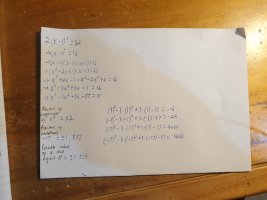Hello
I came across a question in my math textbook that i am confused by.
Below is the question.
[imath]2(x-1)^3=32[/imath]
initially i tried collecting everything to one side, expanding all the terms and then factorizing the new cubic polynomial using the factor theorem and rational root theorem, however i found that this did not work when i tried it as none of the possible values values i got from using the rational root theorem made the equation equal 0. I then took the simpler approach of dividing both sides by 2, cube rooting the right side and then add 1 to the right side, this worked.
What i am asking is why did my first approach not work. below is a picture of my first approach. All help appreciated.

I came across a question in my math textbook that i am confused by.
Below is the question.
[imath]2(x-1)^3=32[/imath]
initially i tried collecting everything to one side, expanding all the terms and then factorizing the new cubic polynomial using the factor theorem and rational root theorem, however i found that this did not work when i tried it as none of the possible values values i got from using the rational root theorem made the equation equal 0. I then took the simpler approach of dividing both sides by 2, cube rooting the right side and then add 1 to the right side, this worked.
What i am asking is why did my first approach not work. below is a picture of my first approach. All help appreciated.

